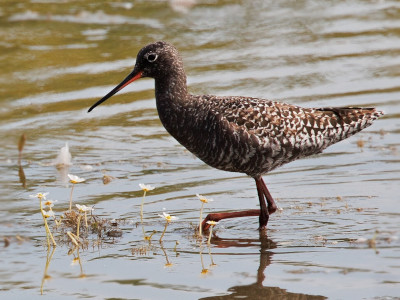 Past Events
Past Events
Walk 13 April 2024
With leaders Cliff Dean and David Bentley, eight of us met in the car park which was otherwise a battleground for territorial male Blackbirds. Clearly the surrounding grass and gardens provide all they need in terms of worms, cosy corners for nesting and song-posts on bushes, fences and rooftops; so ideal in fact that pairs are densely crowded and boundaries constantly disputed.
The preceding days had seen an arrival of many small birds from their wintering grounds in various parts of Africa, so we diverted from our habitual route around Flat Beach through the village and along the track alongside Narrow Pits. Here, Bramble & Hawthorn scrub of varying heights to one side and water and Willow to the other provided diverse habitats for a range of warblers, some of which (Chiffchaff & Blackcap) had been present for a fortnight but others (Whitethroat, Reed & Sedge Warbler) had come in during the week while one (Lesser Whitethroat) had arrived overnight – via an eastern rather than western route.
Most of these birds were hard to see but their songs were loud and distinctive so we spent a lot of time carefully listening, attentive too to the kinds of habitat from which the songs emanated. We watched a Whitethroat’s display flight, dancing about in the air above brambles and noticed BTO Breeding Evidence: not only a Singing Male but a Pair In Suitable Habitat and in fact Nest Building.
Beside these incoming migrants there was quite a range of vociferous resident species, including a Song Thrush delivering excellent mimicry of a car alarm – perhaps the result of living not far from the busy car park! Overhead were squawking Black-headed and yelping Mediterranean Gulls, in the background braying Greylag Geese and one lucky birdwalker caught the call of a Cuckoo.
For those unfamiliar with this Wall of Sound, it can be hard to distinguish one song from another, so we tried to start with Entry Level songs – monotonous Chiffchaff, explosive Cetti’s Warbler, chortling Green Woodpecker for instance – then fill in the gaps…. Some people make a big deal about identifying birds from song but those same people will go to a pub quiz with a music round in which they will instantly recognise songs from the first two notes; and that’s without the birds’ contextual clues of season, habitat etc.

Emerging past a hedge-hopping Sparrowhawk and rasping Sedge Warbler in the warm shelter of the bushes we were exposed to a cool breeze on the causeway to Cuckoo Corner where, to one side were Shelduck, Shoveler and displaying, newly arrived Little Ringed Plovers, and to the other, for comparison, chunky Ringed Plovers and…and…the previously mentioned wintering Spotted Redshank but now almost moulted into fabulous summer plumage of jet black, charcoal grey and the eponymous Spots as well as an eye-ring in silvery white. Restrained yet dramatic, it must be off to the Arctic very soon so take the opportunity to have a look – at the southern end of the Salt Pool.